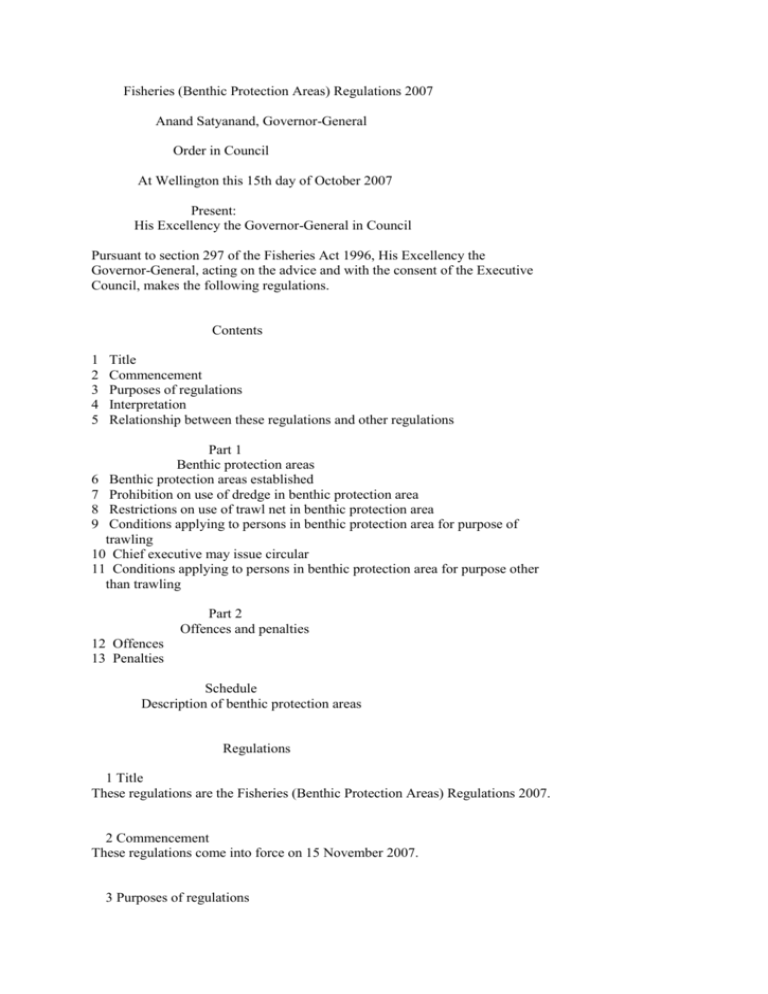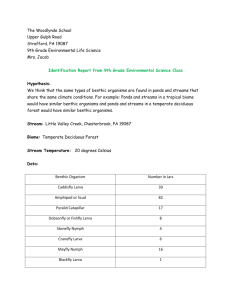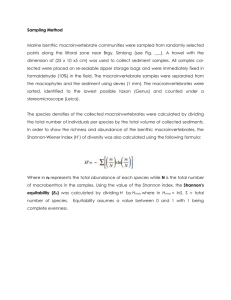Fisheries (Benthic Protection Areas) Regulations 2007
advertisement

Fisheries (Benthic Protection Areas) Regulations 2007 Anand Satyanand, Governor-General Order in Council At Wellington this 15th day of October 2007 Present: His Excellency the Governor-General in Council Pursuant to section 297 of the Fisheries Act 1996, His Excellency the Governor-General, acting on the advice and with the consent of the Executive Council, makes the following regulations. Contents 1 2 3 4 5 Title Commencement Purposes of regulations Interpretation Relationship between these regulations and other regulations Part 1 Benthic protection areas 6 Benthic protection areas established 7 Prohibition on use of dredge in benthic protection area 8 Restrictions on use of trawl net in benthic protection area 9 Conditions applying to persons in benthic protection area for purpose of trawling 10 Chief executive may issue circular 11 Conditions applying to persons in benthic protection area for purpose other than trawling Part 2 Offences and penalties 12 Offences 13 Penalties Schedule Description of benthic protection areas Regulations 1 Title These regulations are the Fisheries (Benthic Protection Areas) Regulations 2007. 2 Commencement These regulations come into force on 15 November 2007. 3 Purposes of regulations The purposes of these regulations are--(a) to establish benthic protection areas within New Zealand's fishery waters: (b) to set out rules that apply to vessels trawling within the benthic protection areas: (c) to prohibit the use of a dredge within the benthic protection areas: (d) to create offences and penalties in relation to any breach of these regulations. 4 Interpretation (1) In these regulations, unless the context otherwise requires,--Act means the Fisheries Act 1996 benthic protection areas mean the areas established by regulation 6 ENMS--(a) means any electronic net monitoring system that collects the information specified in regulation 9(d) and that complies with any standards and requirements specified by the chief executive in a circular issued under regulation 10; and (b) includes--(i) any electronic equipment attached to the trawl net for the purpose of collecting any of the information specified in regulation 9(d) and any device used to store that information; and (ii) any onboard equipment or software used to collect any of the information specified in regulation 9(d) and any device used to store that information; and (iii) all information derived from, or stored using, any equipment described in subparagraph (i) or (ii) lower buffer zone means all water and seabed within the benthic protection areas that is below the upper buffer zone upper buffer zone means all water within the benthic protection areas that is between, and including, the following points: (a) 50 metres directly above the seabed; and (b) 100 metres directly above the seabed. (2) Any term or expression that is defined in the Act or the Fisheries (Commercial Fishing) Regulations 2001 and used, but not defined, in these regulations has the same meaning as in the Act or those regulations. 5 Relationship between these regulations and other regulations (1) The prohibitions and restrictions imposed by these regulations on the use of a dredge and trawling within a benthic protection area apply in addition to any prohibitions and restrictions imposed by any other regulations. (2) For the avoidance of doubt, these regulations do not forbid trawling for the purposes of regulation 74 of the Fisheries (Commercial Fishing) Regulations 2001. Part 1 Benthic protection areas 6 Benthic protection areas established (1) This regulation establishes the benthic protection areas. (2) The areas described in the Schedule--(a) are the benthic protection areas; and (b) include all the waters and seabed in those areas. (3) The benthic protection areas are described in the Schedule as follows: (a) Part 1 of the Schedule contains a map that shows the general locations of the benthic protection areas: (b) Part 2 of the Schedule describes the geographical boundaries of the benthic protection areas (WGS84 projection). (4) In the event of any inconsistency between the benthic protection areas shown in the map in Part 1 of the Schedule and the descriptions of the benthic protection areas in Part 2 of the Schedule, the descriptions in Part 2 prevail. 7 Prohibition on use of dredge in benthic protection area No person may use a dredge within any benthic protection area. 8 Restrictions on use of trawl net in benthic protection area (1) No person may use a trawl net within any benthic protection area unless that person--(a) is trawling only above the upper buffer zone; and (b) complies with the requirements of regulation 9. (2) No person may use a trawl net in the upper buffer zone. (3) No person may use a trawl net in the lower buffer zone. 9 Conditions applying to persons in benthic protection area for purpose of trawling The requirements referred to in regulation 8(1) are that the person--(a) has, before entering a benthic protection area for the purpose of trawling, notified the Fisheries Communication Centre of--(i) the person's intention to use a trawl net; and (ii) the benthic protection area in which the person intends to trawl; and (b) has, after entering a benthic protection area but before commencing trawling, notified the person's intention to commence trawling to an observer on board the vessel; and (c) ensures that no less than 2 observers are on board the vessel at all times during trawling; and (d) carries on board the vessel an ENMS that, when the person is using a trawl net within a benthic protection area, continuously records--(i) the depth of the ground rope and seabed; and (ii) the date and time; and (iii) the latitude and longitude of the vessel; and (iv) any other information specified in a circular issued under regulation 10; and (e) permits inspection of information from the ENMS, at any reasonable time, by a fishery officer or an observer; and (f) supplies the information from the ENMS to a fishery officer on request by that officer; and (g) retains information from the ENMS for a period of not less than 2 years; and (h) complies with any circular issued by the chief executive under regulation 10. 10 Chief executive may issue circular (1) The chief executive may--(a) issue a circular specifying the standards and requirements applying to ENMS for use within a benthic protection area; and (b) amend or revoke the circular. (2) Before issuing, amending, or revoking a circular under subclause (1), the chief executive must consult with any organisations that the chief executive considers to be representative of those classes of persons likely to be substantially affected by the circular. (3) A circular may specify (but is not limited to) all or any of the following standards and requirements: (a) the place on the vessel where the ENMS must be installed: (b) the method of installing the ENMS on a vessel: (c) the form, frequency, and type of ENMS information, including information derived from the ENMS and information relating to the ENMS installed on the vessel: (d) the supply of ENMS information to the chief executive: (e) the places and times at which ENMS information must be supplied: (f) minimum standards and requirements for the ENMS and its operation, including testing, maintenance, and certification of the ENMS. (4) A circular may specify different standards and requirements for different types of ENMS. 11 Conditions applying to persons in benthic protection area for purpose other than trawling Any person using a fishing vessel within a benthic protection area for a purpose other than trawling must ensure that, while within the benthic protection area,--(a) No trawl net or dredge is in contact with the water: (b) No trawl net or dredge is being prepared for use. Part 2 Offences and penalties 12 Offences (1) A person commits an offence who contravenes or fails to comply with the requirements of any of regulations 8(2), 9(a), (b), (g), or (h), or 11. (2) A person commits an offence who contravenes or fails to comply with the requirements of any of regulations 7, 8(3), or 9(c), (d), (e), or (f). 13 Penalties (1) Every person who commits an offence against a regulation specified in regulation 12(1) is liable on summary conviction to a fine not exceeding $20,000. (2) Every person who commits an offence against a regulation specified in regulation 12(2) is liable on summary conviction to a fine not exceeding $100,000. (3) A person is liable on summary conviction to a fine not exceeding $100,000 if--(a) that person has been convicted of 2 or more offences against the regulations specified in regulation 12(1); and (b) the offences were committed on more than 2 occasions within a period of 3 consecutive years. Schedule r6 Description of benthic protection areas Part 1 Map showing general locations of benthic protection areas PLEASE REFER TO HARDCOPY Part 2 Description of geographical boundaries of benthic protection areas (WGS84 projection) Kermadec: An area commencing at the easternmost point of the exclusive economic zone boundary nearest 34o22.10'S 179o29.60'E; then heading in generally north-westerly, northerly, easterly, and southerly directions along the boundary of the exclusive economic zone to the westernmost point of the exclusive economic zone boundary nearest 34o34.20'S 179o51.20'W; then proceeding in a generally westerly direction directly to the point of commencement. Tectonic Reach: A box covering the area commencing at 34o15.60'S 178o58'E; then heading in a generally easterly direction along the boundary of the exclusive economic zone to 34o26'S 179o42'E; then heading in a generally south-westerly direction directly to 36o06'S 178o37.70'E; then heading in a generally north-westerly direction directly to 35o46'S 178o00'E; then heading in a generally north-easterly direction directly to the point of commencement. Norfolk Deep: An area commencing at 30o52.18'S 173o00'E; then heading in a south-westerly direction directly to 33o53.30'S 168o01'E; then heading in a generally north-easterly direction along the boundary of the exclusive economic zone to the point of commencement. Challenger North: A box covering the area between 38o15'S and 40o05'S and 169o40'E and 170o40'E. Challenger South: An area commencing at 41o00'S 168o18'E; then heading south along the 168o18'E line of longitude to 42o40'S 168o18'E; then heading west along the 42o40'S line of latitude to 42o40'S 166o18'E; then heading north along the 166o18'E line of longitude to the intersection with the exclusive economic zone boundary at 41o07.90'S; then following the exclusive economic zone boundary in a generally north-easterly direction to the intersection with the 41o00'S line of latitude at 166o37.50'E; then heading east along the 41o00'S line of latitude to the point of commencement. Hikurangi Deep: A box covering the area between 41o00'S and 42o10'S and 180o00'and 175o00'W. Mid Chatham Rise: A box covering the area commencing at 43o10'S 177o40'E; then heading in a generally easterly direction directly to 43o33'S 179o25'W; then heading in a southerly direction directly to 43o53'S 179o25'W; then heading in a generally westerly direction directly to 43o30'S 177o40'E; then heading in a northerly direction directly to the point of commencement. East Chatham Rise: A box covering the area between 43o10'S and 43o40'S and 175o30'W and 174o20'W. Arrow Plateau: An area commencing at the intersection of the 173o00'W line of longitude with the exclusive economic zone boundary at 41o21.36'S; then heading in generally south-easterly, southerly, and south-westerly directions along the exclusive economic zone boundary to the intersection with the 173o00'W line of longitude; then heading north along the 173o00'W line of longitude to the point of commencement. Fiordland Transect: An area commencing at the intersection of the 45o00'S line of latitude and the seaward boundary of the territorial sea at approximately 166o45.80'E; then travelling in a generally southerly direction along the territorial sea boundary to the intersection of the 46o00'S line of latitude at approximately 166o09.50'E; then heading west along the 46o00'S line of latitude to the intersection with the exclusive economic zone boundary; then following the exclusive economic zone boundary in a generally northerly direction to the intersection with the 45o00'S line of latitude; then heading east along the 45o00'S line of latitude to the point of commencement. Campbell East: A box covering the area between 50o16'S and 51o50'S and 171o50'E and 173o41'E. Antipodes Transect: An area commencing at the point 48o30'S 178o30'E; then heading east along the 48o30'S line of latitude to 48o30'S 179o00'W; then heading south along the 179o00'W line of longitude to 51o00'S 179o00'W; then heading east along the 51o00'S line of latitude to the intersection with the exclusive economic zone boundary; then following the exclusive economic zone boundary in a generally south-westerly direction to the intersection with the 178o30'E line of longitude; then heading north along the 178o30'E line of longitude to the point of commencement. Bounty Heritage: An area covering the existing 12 nautical mile territorial sea limit around the Bounty Islands. Campbell Heritage: An area covering the existing 12 nautical mile territorial sea limit around Campbell Island. Sub-Antarctic Deep: An area commencing at 52o00'S 167o40'E; then heading south along the 167o40'E line of longitude to the intersection with the exclusive economic zone boundary; then heading in a generally north-westerly direction along the exclusive economic zone boundary until reaching the intersection with the 52o00'S line of latitude; then heading east along the 52o00'S line of latitude to the point of commencement. Blink: A box covering the area between 44o42.63'S and 44o42.92'S and 176o14.83'W and 176o14.42'W. Puysegur: A box covering the area between 47o04'S and 47o14'S and 165o35'E and 165o43'E. Diane Morcom, Clerk of the Executive Council. Issued under the authority of the Acts and Regulations Publication Act 1989. Date of notification in Gazette: 18 October 2007. These regulations are administered by the Ministry of Fisheries.






